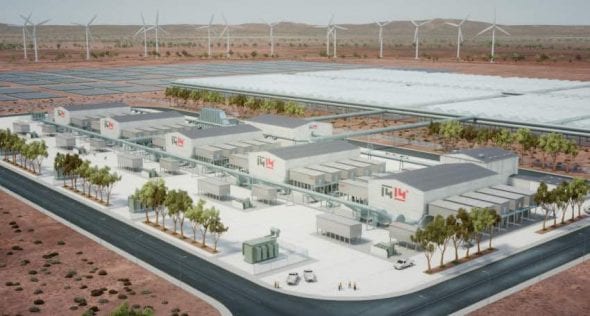1414 plans two “gigawatt hour” silicon storage plants in S.A.
By Andrew Spence on 23 November 2017

The Lead
Energy storage company 1414 Degrees has opened a new factory and will begin building its first commercial system next month before listing on the Australian Stock Exchange in early 2018.

An artist’s impression of a 1GWh integrated system
The South Australian company has spent almost a decade developing its Thermal Energy Storage System (TESS) technology to store electricity as thermal energy by heating and melting containers full of silicon at a cost estimated to be up to 10 times cheaper than lithium batteries.
1414 Degrees has moved into a 3000sq m factory on the site of the former Mitsubishi engine plant in the southern Adelaide suburb of Lonsdale where it will build its first 10MWh TESS-IND system and the first 13.3MWh test cell for a 200MWh TESS-GRID system.
The company is also planning to initially build two grid scale 1GWh systems in South Australia, which would be comprised of five 200MWh units and potentially play a significant role in stabilising the state’s renewable energy-dependent electricity network.
1414 Degrees has submitted three applications to the South Australian Government’s $150 million Renewable Technology Fund, which has already allocated up to $20 million towards Tesla’s ‘world’s biggest’ lithium-ion battery being built in the state’s Mid North.
Executive Chairman Dr Kevin Moriarty said 1414 Degrees was aiming to list on the Australian Stock Exchange in March or April after it had learned the outcome of its funding applications, which require matching funding.
He said the IPO would plan to raise at least $30 million to support the development of the technology.
“It hasn’t been difficult to raise money but we do need to offer liquidity to shareholders so we are planning to list at the earliest opportunity rather than continuing to raise privately,” Dr Moriarty said.
A tonne of silicon can store enough energy to power up to 28 houses for a day.
Its high latent heat capacity and melting temperature of 1414 C make silicon ideal for storing large amounts of energy.
The process also generates clean useable heat, which can easily be utilised for district heating or industrial purposes.
The 10MWh systems would use about 20 tonnes of silicon, pictured below, and be targeted at industries that required electricity and heat. It is likely the first units will be sent to New South Wales and used in large greenhouses.

“We can extract about half of the energy as electricity and the rest is available as heat. If we can use that heat, which is required by industries and households around the world, we can achieve 90 per cent or more efficiency from the renewable sources,” Dr Moriarty said.
“Our target is industry seeking to reduce energy costs or emissions.
“We allow them to do all of that by putting in their own solar or buying energy when it’s cheap and then releasing it when it’s expensive.”
South Australia leads the nation in the uptake of wind energy and rooftop solar with renewable sources accounting for more than 40 per cent of the electricity generated in the state.
However, the intermittent nature of renewable energy has been the cause of intense debate in Australia in the past 12 months.
“There’s a number of solutions out there from batteries to pumped hydro but the one thing missing is something that’s proven, scalable and is going to provide a low-cost solution that can be adopted everywhere,” Dr Moriarty said.
“If we are going to solve the issues around renewable energy we have to solve the issues around storage.
“South Australia is a particularly good laboratory because it’s one of the first places in the world where a very large proportion of renewable energy is exposing the issues around incorporating these technologies into the electricity grid.”

The proposed 1GWh systems include one near the 1414 Degrees factory in Adelaide. It would be connected to the electricity grid and purchase electricity when prices are low, store it and sell it back at times of peak demand and higher prices.
Dr Moriarty said the second system would likely be connected to a solar farm and would store the excess energy it couldn’t sell directly to the grid. He said ideally it would be co-located with industries that were looking for a lot of heat such as poultry producers, food manufacturers and greenhouses.
“These industries all currently use gas and this will mean that solar will effectively be displacing gas and therefore reducing emissions,” he said.
“Once you generate the electricity the heat that’s coming off is anything from 400 to 600 degrees and that’s ideal for driving steam and other processes.”
The first 10MWh “off the shelf” unit is expected to be commissioned in January.
1414 Degrees has been approached by distributors in Australia, South Africa, Asia, the Middle East and Europe to sell the 10MWh systems as part of a renewable energy technology solution.

“We expect to draw up our first agreements very soon. This will mean the company can use its workforce to manufacture the machines and the distributors will take care of the assessment of sites and sales,” Dr Moriarty, pictured above, said.
“Once we get a production line going it will be quite fast – it’s just a question of building a supply chain.
“This technology is going to have major growth and it’s going to be manufacturing intensive because the market is huge.
“That means there’s going to be thousands of the smaller 10MWh units and hundreds at least of the large units required in Australia and around the world.”
reneweconomy.com.au
My comments:
Si is one of the ultimate "phase change" elements able to store thermal energy.
This will be a game changer in the stationary energy storage sector.
Eric |








